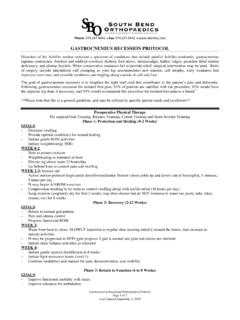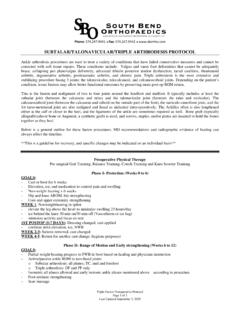Transcription of PLANTAR FASCIITIS PROTOCOL - South Bend Orthopaedic …
1 Phone: Fax: PLANTAR Fascia PROTOCOL Page 1 of 4 Last Updated September 3, 2020 PLANTAR FASCIITIS PROTOCOL PLANTAR FASCIITIS is an inflammatory condition that occurs as a result of overstressing the PLANTAR fascia. It is the most common cause of inferior heel pain and has been diagnosed in patients from the ages of 8 years to 80 years old. PLANTAR FASCIITIS affects approximately 10% of the population and is more commonly found in middle-aged women and younger male runners. Bilateral symptoms can occur in 20-30% of those diagnosed with PLANTAR FASCIITIS . However in these cases it is important to rule out other systemic processes such as rheumatoid arthritis, systemic lupus erythematosus, Reiter s disease, gout and ankylosing spondylitis.
2 The primary symptom of PLANTAR FASCIITIS is pain in the heel when the patient first rises in the morning and when the PLANTAR fascia is palpated over it s origin at the medial calcaneal tuberosity. The PLANTAR fascia (aponeurosis) is a thick fibrous band of connective tissue that originates at the medial and lateral tuberosities of the calcaneus. The etiology of PLANTAR FASCIITIS is multifactorial. The tension placed on the PLANTAR fascia will increase as a result of anatomical factors such as abnormal foot posture or tight/weak posterior calf musculature. In addition, environmental factors such as increased frequency/distance/speed of walking or running, a change in terrain or changes in foot wear will place abnormal stress on this tissue structure.
3 However it appears that the combination of both anatomical and environmental factors eventually lead to dysfunction and overload of the fascia. Pain in PLANTAR medial heel which is increased with first few steps out of bed in the morning or after a period of inactivity. Pain also worsens after prolonged weight bearing activity. May be precipitated after a recent increase in weight-bearing activity such as walking or running or after an increase in weight gain. Risk factors include limited ankle dorsiflexion and high body mass index in non-athletic populations. The most common risk factors associated with PLANTAR FASCIITIS are: - Tightness or weakness of the posterior calf musculature - Pes planus or pes cavus foot structures - Sudden gain in weight or obesity - Unaccustomed walking or running ( increased speed, distance or uphill) - Change in walking or running surface - Occupations involving prolonged weightbearing - Shoes with poor cushioning Each of the above factors can predispose an individual to PLANTAR FASCIITIS due to abnormal biomechanics in the foot.
4 According to the literature, approximately 80-90% of people suffering from PLANTAR FASCIITIS will have a complete resolution of their symptoms in 6-18 months, with or without treatment. Rule out the following differential diagnoses: - Haglunds Deformity - Flexor Hallicus Longus/Peroneal Longus - Flexor Digitorum Longus - Gluteus medius strength - Hamstring tightness - Calcaneal stress fracture - Calcaneal nerve compression - Bone bruise - Fat Pad Atrophy - Tarsal Tunnel Syndrome - Soft tissue, primary, or metastatic bone tumor - Paget disease of bone - Reiter s Syndrome - Sever s disease Referred pain as a result of an S1 radiculopathy PLANTAR Fascia rupture STAGES OF PLANTAR FASCIITIS : - Stage I: Acute reversible inflammation.
5 Minor achy pain after heavy activity or with first initial steps after period of inactivity. Symptoms are not constant and may resolve after basic anti-inflammatory measures followed by stretching exercises. - Stage II: Intense pain with activity and symptoms also at rest. Usually can still perform routine activities. Decreased inflammatory cells and increased angiofibroblastic invasion. May have developed calcaneal spur. Phone: Fax: PLANTAR Fascia PROTOCOL Page 2 of 4 Last Updated September 3, 2020 - Stage III: Intense pain with activity and at rest. Significant functional limitations because of pain and cannot perform routine activities.
6 May have partial or full rupture of PLANTAR fascia. Extensive angiofibroblastic invasion. Phases / Stages of healing : Evidence-Based PROTOCOL for Progression of Activities Acute Stage (0 to 4 weeks) GOALS: - Decrease pain & inflammation - Improve function, flexibility, and ROM - Iontophoresis (Osborne & Allison 2006) - Dexmethasone or 5% acetic acid - Ultrasound, phonophoresis, electrical stimulation , ice, heat Taping (Hyland et al 2006) - Calcaneal/Navicular sling or low dye taping Activity Limitations - Use reproducible measure of activity restrictions secondary to heel pain to determine if interventions are effective.
7 Ie: Patient unable to stand longer than 5 minutes - without heel pain and now can stand for 15 minutes without heel pain or use numeric pain scale. Helps demonstrate to clinician and patient whether interventions are working. - Gastroc stretching with big toe dorsiflexed - Gentle soft tissue mobilization Subacute Stage II (4 weeks to 3 months) GOALS: - Improve function - Decrease pain - Improve joint mobility - Improve neural mobility (Meyer et al 2002) - Improve soft tissue mobility - Provide stability during weight-bearing activities - Manual Therapy (Young et al 2004) o Talocrural joint posterior glides o Subtalar joint lateral glides o Ant/Post glides of 1st TMT joint o Subtalar joint distraction manipulations o Increased pain noted with SLR test with passive dorsiflexion and eversion to put increased stress on tibial nerve - Passive and active mobilization of soft tissue aimed at restoring pain-free mobility along the course of the median nerve o Perform procedures in a slumped sitting position o 10 treatment sessions over a 1 month period of time o May provide short term pain relief (1-3 mos)
8 And improvement in function Calf and PLANTAR fascia stretching (Porter et al 2002) - Calf muscle or PLANTAR fascia specific stretching can be performed 2-3 times per day. - Transverse friction massage - Foot intrinsic strengthening exercises - Ankle balance board exercise, BAPS - Correct lower quarter imbalances in flexibility and strength Footwear type/foot assessment Phone: Fax: PLANTAR Fascia PROTOCOL Page 3 of 4 Last Updated September 3, 2020 Chronic 3 months to 1 year Goals - Improve function - Work toward return to sport/recreational activity - Continue to improve joint and soft tissue mobility - Continue to improve neural mobility if appropriate - Make referral to appropriate medical professionals if necessary - Night Splints (Crawford/Thomson 2003)
9 - Should be considered as an intervention in patients with symptoms greater than 6 month duration - Desired length of time for wearing the device is 1-3 months - The type of night splint used (posterior/anterior/sock-type) does not appear to affect the outcome - Continue with interventions cited in Phase II if proven effective with functional outcome questionnaires There is no guarantee on outcome. All conservative management options have risk of worsening pain, progressive irreversible deformity, and failing to provide substantial pain relief. All surgical management options have risk of infection, skin or bone healing issues, and/or worsening pain.
10 Our promise is that we will not stop working with you until we maximize your return to function, gainful work, and minimize pain. REFERENCES 1. Tisdel CL, Donley BG, Sferra JJ. Diagnosing and treating PLANTAR FASCIITIS : A conservative approach to PLANTAR heel pain. Cleve Clin J Med. 1999;66:231-235. 2. Singh D, Angel J, Bentley G, Trevino SG. Fortnightly review. PLANTAR FASCIITIS . BMJ. 1997;315:172-175. 3. DeMaio M, Paine R, Mangine RE, Drez D,Jr. PLANTAR FASCIITIS . Orthopedics. 1993;16:1153-1163. 4. Barrett SJ, O'Malley R. PLANTAR FASCIITIS and other causes of heel pain. Am Fam Physician.




